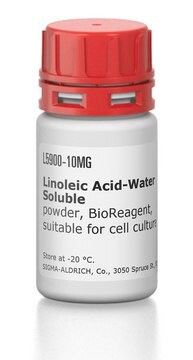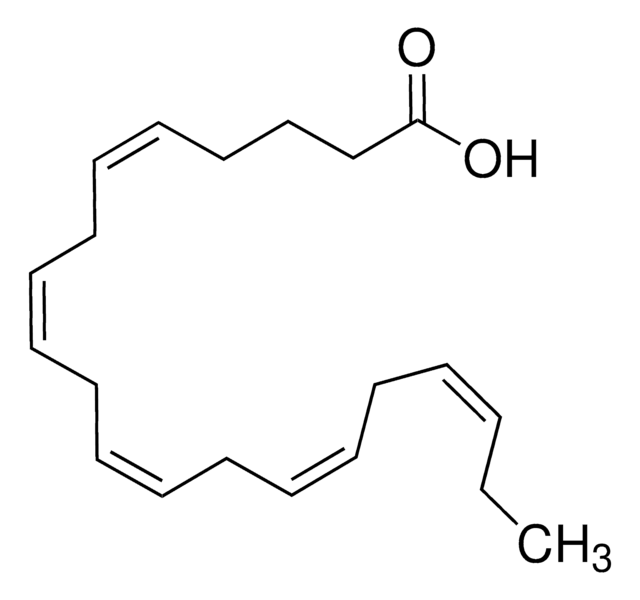L2376
Linolenic acid
≥99%
Sinonimo/i:
α-Lnn, cis,cis,cis-9,12,15-Octadecatrienoic acid
About This Item
Prodotti consigliati
Saggio
≥99%
Indice di rifrazione
n20/D 1.480 (lit.)
P. ebollizione
230-232 °C/1 mmHg (lit.)
Punto di fusione
-11 °C (lit.)
Densità
0.914 g/mL at 25 °C (lit.)
Tipo di lipide
omega FAs
Temperatura di conservazione
−20°C
Stringa SMILE
CC/C=C\C/C=C\C/C=C\CCCCCCCC(O)=O
InChI
1S/C18H30O2/c1-2-3-4-5-6-7-8-9-10-11-12-13-14-15-16-17-18(19)20/h3-4,6-7,9-10H,2,5,8,11-17H2,1H3,(H,19,20)/b4-3-,7-6-,10-9-
DTOSIQBPPRVQHS-PDBXOOCHSA-N
Cerchi prodotti simili? Visita Guida al confronto tra prodotti
Descrizione generale
Applicazioni
- to assess the total antioxidative activity of serum and bacteria
- in palleroni chamber assay
- to prepare free fatty acid mixture
Azioni biochim/fisiol
Confezionamento
Codice della classe di stoccaggio
10 - Combustible liquids
Classe di pericolosità dell'acqua (WGK)
WGK 1
Punto d’infiammabilità (°F)
235.4 °F - closed cup
Punto d’infiammabilità (°C)
113 °C - closed cup
Dispositivi di protezione individuale
Eyeshields, Gloves
Scegli una delle versioni più recenti:
Possiedi già questo prodotto?
I documenti relativi ai prodotti acquistati recentemente sono disponibili nell’Archivio dei documenti.
I clienti hanno visto anche
Articoli
Importance and uses of linolenic acid in serum-free eukaryotic, including hybridoma and Chinese Hamster Ovary (CHO) cell, cultures
AEM3-944 | UAT | Prefill feature for related product categories not working
Omega-3 Fatty Acids and Heart Disease
Lipid Induced Insulin Resistance
Il team dei nostri ricercatori vanta grande esperienza in tutte le aree della ricerca quali Life Science, scienza dei materiali, sintesi chimica, cromatografia, discipline analitiche, ecc..
Contatta l'Assistenza Tecnica.





